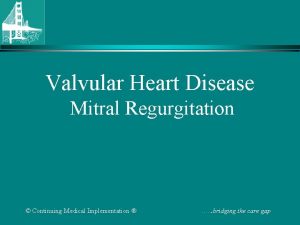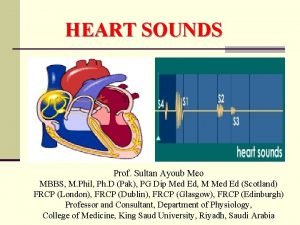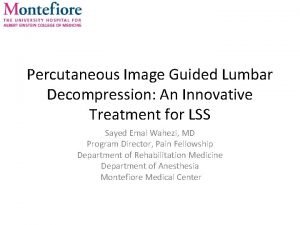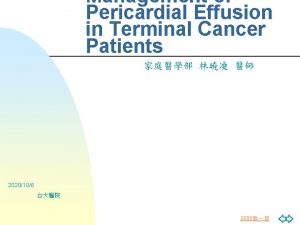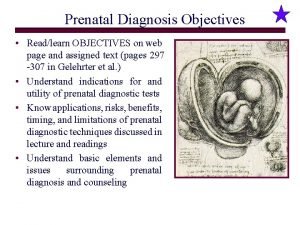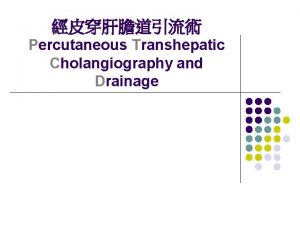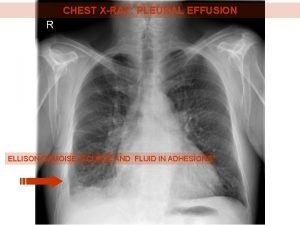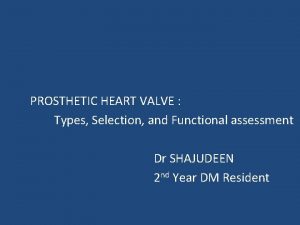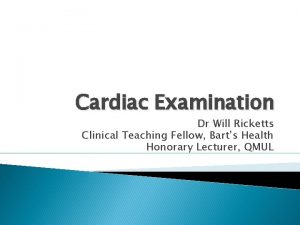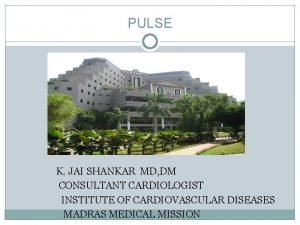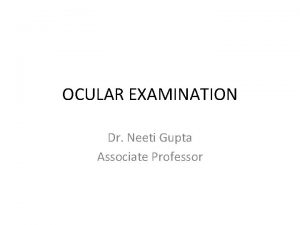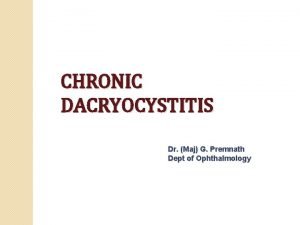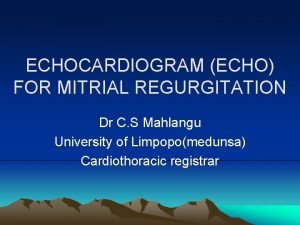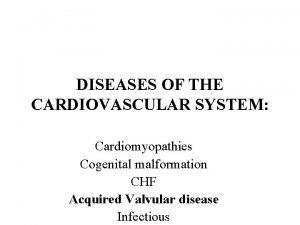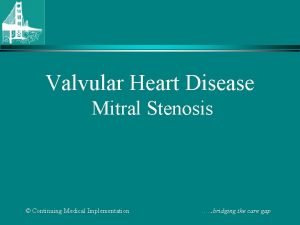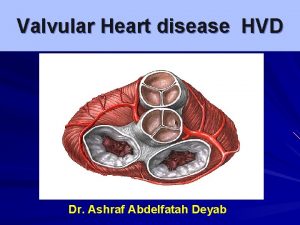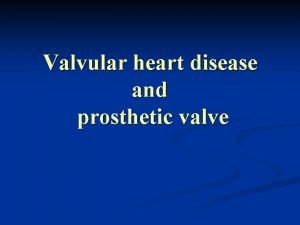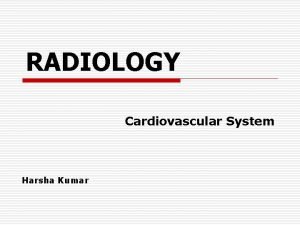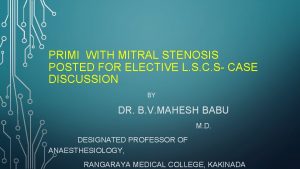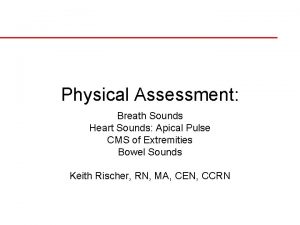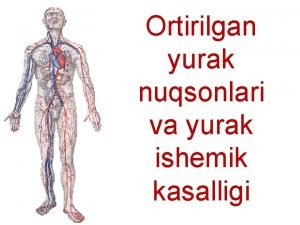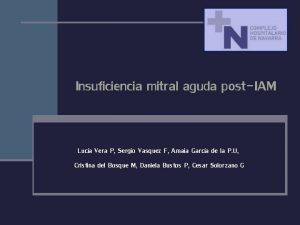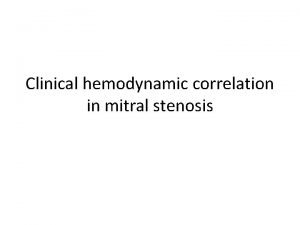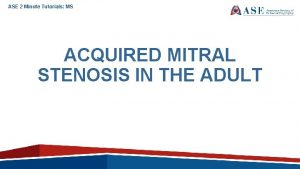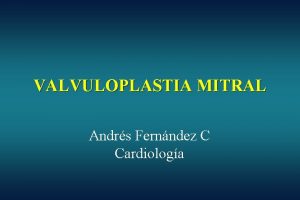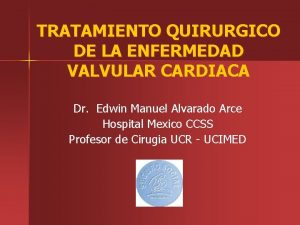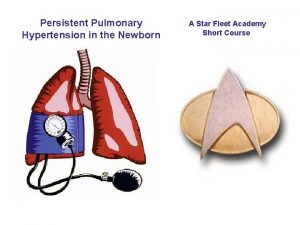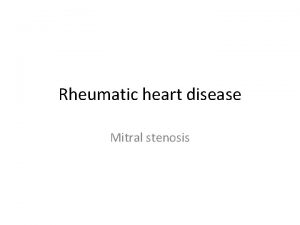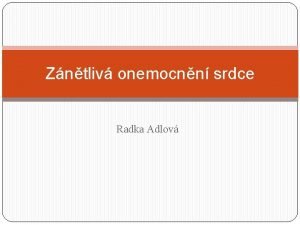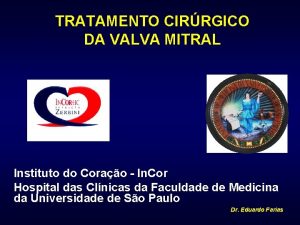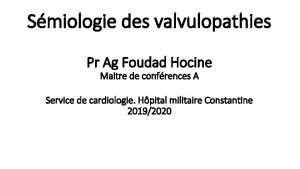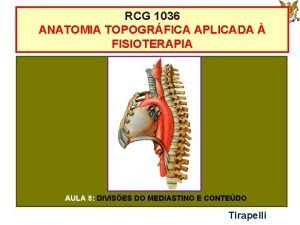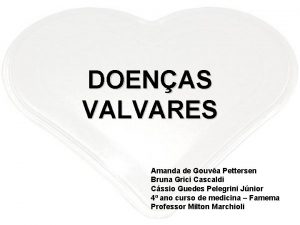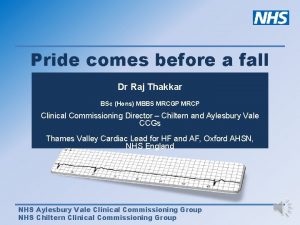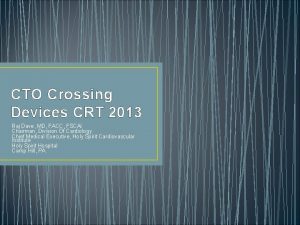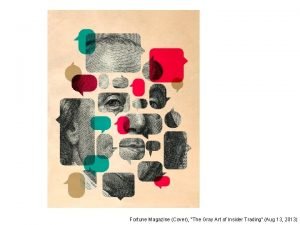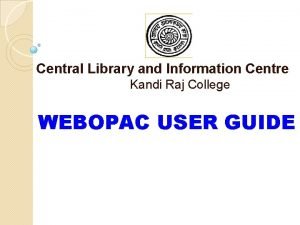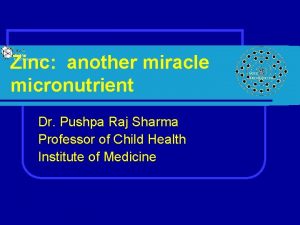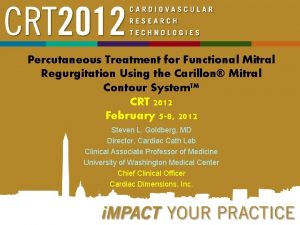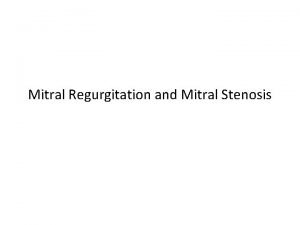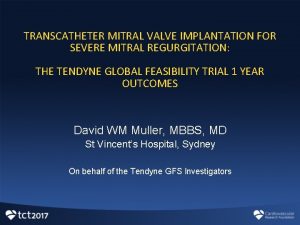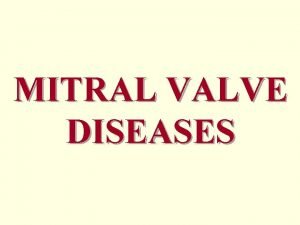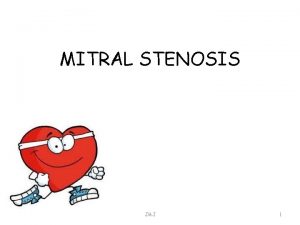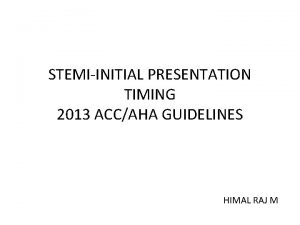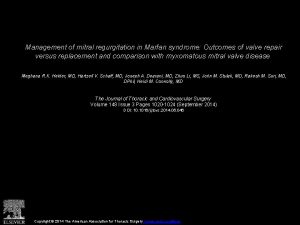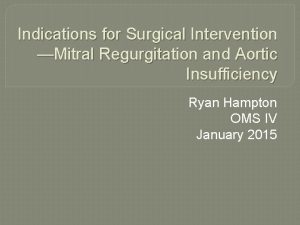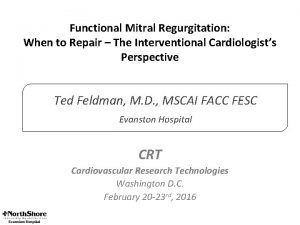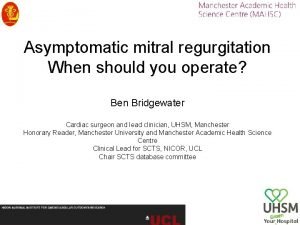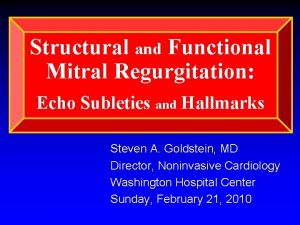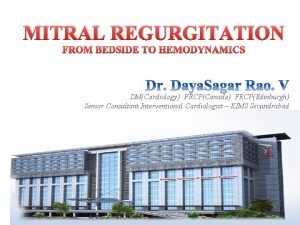PERCUTANEOUS MANAGEMENT OF MITRAL REGURGITATION DR HIMAL RAJ




































































- Slides: 68

PERCUTANEOUS MANAGEMENT OF MITRAL REGURGITATION DR. HIMAL RAJ. M

INTRODUCTION • Severe mitral regurgitation - insidious disorder • Medical therapy relieves symptoms - not underlying mitral pathology • Surgical treatment for MR: MVR MV repair (MVRe) Ø superior long-term outcomes

INTRODUCTION • Transcatheter MV therapies - slower development path -complex anatomy of MV and mitral apparatus Ø minimally invasive approaches – for elderly, severe LV dysfunction and significant comorbidities

CLASSIFICATION • Based on functional anatomy • groups devices into those targeting : – leaflets (percutaneous leaflet plication, percutaneous leaflet coaptation, percutaneous leaflet ablation) – annulus (indirect: coronary sinus approach or an asymmetrical approach; direct: true percutaneous or a hybrid approach) – chordae (percutaneous chordal implantation) – LV (percutaneous LV remodeling)

Circ Cardiovasc Intervent. 2009; 2: 140 -146. )

Leaflet Repair - EDGE-TO-EDGE TECHNIQUE • 1991 - Alfieri et al - suturing leaflets together to reduce MR in degenerative MR (edge-toedge leaflet repair) • Suturing anterior and posterior mitral leaflet edges near their midpoints double-orifice valve


mmcts. 2009. 004002

key exclusion criteria – – Recent myocardial infarction – – Any interventional or surgical procedure within 30 days of the index procedure – – Mitral valve orifice area <4 cm 2 – – Renal insufficiency, endocarditis, rheumatic heart disease mmcts. 2009. 004002

mmcts. 2009. 004002




• The Mitra. Clip device - 4 -mm-wide cobalt -chromium implant with two arms that are opened and closed with the use of the delivery-system handle. • The steerable guide catheter and clip delivery system (CDS) are advanced inside the 14 F – 16 F guide catheter. • Once the CDS is axially aligned perpendicularly above the line of coaptation of the mitral valve, the clip is opened to 180, the grippers are elevated and the CDS is oriented perpendicular to the free edge of the leaflets.

Data: –EVEREST I: Feasibility study (n=55) –EVEREST II: Randomized trial (n=279) –REALISM: Registry –ACCESS Europe: Registry –TRAMI: Registry –GRASP: Registry –COAPT: Ongoing randomized study to study safety and efficacy • –RESHAPE-HF: Randomized study, clip vs. medical therapy • •

EVEREST I Endovascular Valve Edge to edge REpair STudy

EVEREST II Study Design Prospective, randomized, multicenter study Control: surgical mitral valve repair/ replacement Patients randomized 2: 1 37 centers in US and Canada Primary Effectiveness Endpoint Freedom from surgery, death, and moderate to severe (3+) or severe (4+) mitral regurgitation at 12 months. Primary Safety Endpoint Freedom from MAE at one month

OUTCOMES Randomly assigned 279 patients in a 2 -to-1 ratio to undergo either percutaneous repair (184 patients) or mitral-valve surgery (95 patients) of mitral regurgitation N Engl J Med 2011; 364: 1395 -406


Conclusions from EVEREST II 4 Year Follow up • At 4 years - surgery remains the standard of care for treatment of MR among eligible patients. • Percutaneous repair -similar mortality and symptomatic improvement but higher rate of MR requiring repeat procedures • percutaneous repair - higher rate of residual MR at 1 year- no difference in later occurrence of MR or mitral valve intervention between 1 -year and 4 -year follow up

TRAMI (Transcatheter Mitral Valve Interventions) register - The German mitral register • Established in 2010 in order to assess the safety and efficacy of percutaneous mitral valve therapy in Germany • The TRAMI registry is the largest real world cohort of patients treated with Mitra. Clip • Mitral Clip was found to be safe and established risk factors for conventional cardiac mitral valve surgery, such as advanced age (≥ 76 years), female gender, severely reduced LV-EF (<30%) and high logistic Euro. Score(≥ 20%) were not predictive for mortality or major complication rates.

For whom is Mitra Clip Therapy? • Mitra clip can be considered as a new treatment option in the following cases: • Patients with primary. MR, severe LV dysfunction(LVEF<30%) and relevant co-morbidities. • Symptomatic patients with severe secondary. MR, severe LV dysfunction(EF<30%) and no option for revascularization. • Symptomatic patients with severe secondary. MR with mild to moderate LV dysfunction (EF>30%), no option for revascularization and relevant co-morbidities. • high operative risk or are inoperable. • safe treatment option with low 30 day mortality


INDIRECT ANNULOPLASTY CS Approach (CS Reshaping)

• A device placed in the coronary sinus to create tension that is transmitted to annulus. • Thus, the annular circumference is decreased and mitral leaflet coaptation improves.



Carillon mitral contour system

Carillon Device Patient Selection: • Moderate to severe FMR due to ischemic or non ischemic cardiomyopathy. • NYHA class II-IV • LV EF <40% • Dilated mitral annulus/insufficient coaptation length. • CRT candidates prior to CRT implant. • Stable heart failure medication for 3 months Exclusion Criteria: • Primary mitral regurgitation. • Coronary artery disease requiring revascularization. • Presence of coronary sinus lead • Significant renal insufficiency (serum creatinine >2. 2 mg/dl

Conclusions of AMADEUS Trial • Percutaneous placement of a mitral annuloplasty device based in the coronary sinus (CARILLON Mitral Contour System) has the potential to safely and significantly treat FMR in patients with heart failure with resultant symptomatic benefit

Circulation. 2009; 120: 326 -333

Conclusions of TITAN Trial • This study demonstrates that percutaneous CS -based mitral annuloplasty can significantly and safely reduce functional MR severity in HF patients • There is significant LV reverse remodelling over 12 months and improved measures of clinical outcome over 24 months


• The Viacor PTMA system uses 2 primary structural elements: a multilumen PTFE (Teflon) PTMA catheter and Nitinol (nickeltitanium alloy) PTMA treatment rods. • The Viacor 7 F, 3 -lumen PTMA diagnostic multilumen catheter was advanced over a 0. 035 -in guide wire through the CSG sheath and into the coronary sinus under fluoroscopic guidance.





Circ Cardiovasc Interv 2009; 2; 277 -284


EVOLUTION Phase I Study J Am Coll Cardiol Intv 2011; 4: 115– 22

J Am Coll Cardiol Intv 2011; 4: 115– 22


Device Name Company Name Trial Technique Current status Carillon Mitral Contour Cardiac Dimensions, Inc. AMADEUS, TITAN, INTEGRAL, TITAN II Indirect annuloplasty Ongoing, CE Monarc Edwards Lifesciences EVOLUTION I, EVOLUTION II Indirect annuloplasty Suspended Viacor PTMA Viacor, Inc. PTOLEMY, PTOLEMY II Indirect annuloplasty Suspended Mitral Cerclage Annuloplasty National Institutes of Health Animal study Indirect annuloplasty Animal model

Direct Annuloplasty

• Percutaneous energy-mediated cinching approach to direct annuloplasty have included the following: – Quantum. Cor device – Re. Cor device –: high intensity focused ultrasound circumferentially

Catheterization and Cardiovascular Interventions Volume 74, Issue 1, pages 43– 48, 1 July 2009


Annuloplasty—Direct: Percutaneous Mechanical Cinching Approach


• The Mitralign Percutaneous Annuloplasty System consists of the following devices: – Deflectable guide catheter – Crossing wire – “Bident” translational catheter – Pledget Delivery Catheter – Plication Lock Delivery Catheter

• Femoral access (14 Fr. ) approaching the posterior mitral annulus via the left ventricle • 2 pairs of surgical pledgets are delivered to the posterior mitral annulus in the area of P 1 and P 3 • Pledgets are pulled together (plicated) and locked • Potential to Customize Therapy: – Option to implant 1, 2 or 3 pairs of pledgets – Adjust the amount of plication to match the heart size or extent of mitral regurgitation – Target the location of the implant to match the MR jet


Annuloplasty—Direct: Hybrid Approach


Ventricular remodeling

• reduce ventricular dilation by directly remodelingthe LV while also compressing the mitral annular septal-lateral dimension • Through a pericardial subxiphoid approach, 2 epicardial pads connected by a flexible suture like cord placed on the LV surface • The cord is passed through the LV between the 2 papillary muscles, bisecting the ventricle. • Shortening of the cord reduces LV size in an anteroposterior dimension

Euro Intervention Supplements (2006) 1 (Supplement A)

Euro Intervention Supplements (2006) 1 (Supplement A)

RESTOR-MV TRIAL • significant sustained reductions in LV chamber dimensions and volume • Reduced MR • and improved survival- compared with mitral annuloplasty

Chordal repair

• Mitra. Flex™ is a mitral valve repair system designed for direct thorascopic approach through the apex of a beating heart. The Mitra. Flex™ system performs the following functions on a beating heart: • Stabilization and centering of the mitral valve leaflets • Automatic capturing and connection of the approximate midpoint of the leaflets • Implantation of an artificial cordae tendonae that controls the movement of the valve leaflets and reduces the annulus thereby reducing or eliminating mitral valve regurgitation

Transcatheter Chordal Implants The Mitra. Flex device sheath (Trans. Cardiac Therapeutics, Atlanta, Georgia) (top left), clip for leaflet plication (top middle), and artificial chord implantation (top right); the Neo. Chord device (Neochord, Inc. , Minnetonka, Minnesota) implanted from a transapical approach (middle); the Babic device (bottom).

Percutaneous MV Replacement • early stages • Replacement devices for direct left atrial, antegrade, transseptal and apical delivery being tested in bench and pre-clinical models • small number of patients

CURRENT GUIDELINES Nishimura, RA et al. 2014 AHA/ACC Valvular Heart Disease Guideline

• The percutaneous mitral clip procedure may be considered in patients with symptomatic severe secondary MR despite optimal medical therapy (including CRT if indicated) • who fulfil the echo criteria of eligibility • are judged inoperable or at high surgical risk by a team of cardiologists and cardiac surgeons and • who have a life expectancy greater than 1 year (recommendation class IIb, level of evidence C). ESC 2012

CONCLUSION • The different percutaneous methods are in their different phases of evolution with few already out of race due to unacceptable practical problems. • As the experience will grow, there will be improvement in both the design of the devices and the competence of the operators. • different techniques have to be used in combination to offer an effective and long lasting solution.

THANK YOU
 Mitral regurgitation symptoms
Mitral regurgitation symptoms Systolic murmur
Systolic murmur Mitral regurgitation murmur
Mitral regurgitation murmur Percutaneous image-guided lumbar decompression (pild)
Percutaneous image-guided lumbar decompression (pild) Terminal testicular cancer
Terminal testicular cancer Indication for cholecystectomy
Indication for cholecystectomy Percutaneous umbilical blood sampling
Percutaneous umbilical blood sampling Bile color
Bile color Ellis curve pleural effusion
Ellis curve pleural effusion Triluminate pivotal trial
Triluminate pivotal trial Jet fazil
Jet fazil Pannus
Pannus Tricuspid regurgitation echo assessment
Tricuspid regurgitation echo assessment Normal apex beat
Normal apex beat Peripheral signs of aortic regurgitation
Peripheral signs of aortic regurgitation Regurgitation test
Regurgitation test Chronic dacryocystitis stages
Chronic dacryocystitis stages Mitrial regurgitation
Mitrial regurgitation Tricuspid valve
Tricuspid valve L
L Professor richard schilling
Professor richard schilling Define mitral stenosis
Define mitral stenosis Lvvo heart
Lvvo heart Tendinous cords
Tendinous cords Rvh cxr
Rvh cxr Rhuematic
Rhuematic Atheromatous thoracic aorta
Atheromatous thoracic aorta Mitral stenosis echo guidelines
Mitral stenosis echo guidelines Apical pulse and mitral valve
Apical pulse and mitral valve Mitral klapan
Mitral klapan Diyastolik rulman nedir
Diyastolik rulman nedir Insuficiencia mitral
Insuficiencia mitral Ef slope in echo
Ef slope in echo Pressure half time formula
Pressure half time formula Score wilkins estenosis mitral
Score wilkins estenosis mitral Valvula mitral en paracaidas
Valvula mitral en paracaidas Mitral stenosis pulmonary hypertension
Mitral stenosis pulmonary hypertension Mitral klapan yetishmovchiligi
Mitral klapan yetishmovchiligi Mitral facies pathophysiology
Mitral facies pathophysiology Valvula mitral
Valvula mitral Estenose mitral
Estenose mitral Choc de pointe globuleux en dome de bard
Choc de pointe globuleux en dome de bard Mediastino limites
Mediastino limites Tendyne
Tendyne Valva mitral
Valva mitral Ramraj science institute nashik
Ramraj science institute nashik Raj chudgar
Raj chudgar Rajswan
Rajswan Raj swan
Raj swan Raj net
Raj net Ravi raj production
Ravi raj production Raj thakkar
Raj thakkar Priasoft accounting
Priasoft accounting Panchayati raj institutions accounting software (priasoft)
Panchayati raj institutions accounting software (priasoft) Balwant rai mehta committee
Balwant rai mehta committee Raj singamsetti
Raj singamsetti Dr pushpa raj sharma
Dr pushpa raj sharma Raj dave md
Raj dave md Raj rajaratnam asha pabla
Raj rajaratnam asha pabla Uom webopac
Uom webopac Webopac uom
Webopac uom Raj rani vs prem adib
Raj rani vs prem adib Pushpa raj sharma
Pushpa raj sharma Raj sunderraman
Raj sunderraman Azharul raj
Azharul raj Raj kumari amrit kaur coaching scheme
Raj kumari amrit kaur coaching scheme Pushpa raj sharma
Pushpa raj sharma Kumar raj kharel
Kumar raj kharel Dr pushpa raj sharma clinic
Dr pushpa raj sharma clinic
